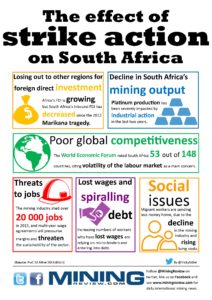
The global mining crisis, which has affected mining regions around the world, has also taken a heavy toll on South Africa’s mining sector. External pressures such as plummeting commodity prices, of sometimes well over 50%, have had a severe effect. But these global pressures have been worsened by South Africa-specific conditions.
South Africa’s mining industry faces the additional impact of what is internationally considered a very poor and volatile labour relations climate, regulatory uncertainty, and tough and disruptive government safety interventions (Section 54s).
It has also felt the impact of Eskom’s load-shedding and sharply rising power costs, increasing limits on ready access to infrastructure, and an aging and maturing mining base.
The outlook for 2016 is muted to say the least. Although the mining industry has been provided some relief from a sharply weaker rand following the [former finance minister Nhlanhla] Nene crisis, as evident in the financial results of some of the companies which have recently reported results for 4Q 2015, few experts expect US commodity prices to recover in the year ahead. Platinum group metals have already suffered six to seven years of pain. Although several mine closures and capital curtailment have already had a modest impact on supply, further closures in 2016 are expected as difficult decisions have to be taken to bring sustainable margins back to the industry.
The ferrous industry (iron ore and manganese) has probably seen the most brutal price corrections and, structurally, has the weakest outlook as new mines coming on line globally operate at far lower costs than those in South Africa, while high-cost Chinese production tends to act irrationally due to heavy state support. South Africa, however, has unique quality assets and post the necessary heavy cost restructuring, should be able to sit out the storm.
Despite the more than halving of export coal prices, high quality key export mines seem to be holding up with the help of the weaker rand. Reduced prices have, however, highlighted the continued need for cost-effective infrastructure for bulk commodities. The Richards Bay line, for example, has managed to maintain volumes, although the far more expensive Maputo export route has essentially halted most coal exports.
Mining companies have responded to pressures by reducing overheads and head office costs, often radically, with Kumba Iron Ore, for example, having reduced head office by 61% in the past year. As this proved to be insufficient to negotiate the current price crisis, severe cuts at the operational level were also announced recently.
South African banks, in general, have relatively broad exposures to companies active in the mining sector. Consequently, the global mining crisis is forcing most banks to critically re-assess and track their existing exposures, and proactively manage these. When, for example, company credit downgrades occur, risk management frameworks often force banks to reduce facility sizes to affected companies when they come up for re-financing. In addition, new projects able to attract bank debt funding also reduce substantially.
With commodity prices having declined significantly, few projects can meet funders’ risk management requirements. Essentially, lower cost projects should survive financially, while many higher cost producers will encounter financial difficulties. The restrictions on sources of funding as the crisis bites will act as an additional brake on industry capacity growth which, in time, should put a firmer floor under commodity prices.
Importantly, banks will focus foremost on the ability of companies and projects to generate cash in tough commodity environments.
However, South Africa’s regulatory, labour and investment mining climate imposes further questions on the reliability and predictability of these cash flows.
It therefore remains imperative to avoid the type of disruptive and radical industry upheavals seen in the South African mining industry over the past few years. Confidence is at a low, and if this results in further limitations on the ability of the industry to fund continuation and growth, the consequences will be far graver beyond the impact of the [commodity price] upheaval itself.
Henk de Hoop is the business development director for resources at Rand Merchant Bank
http://mg.co.za/article/2016-02-19-00-south-african-mining-sector-faces-a-tough-year

